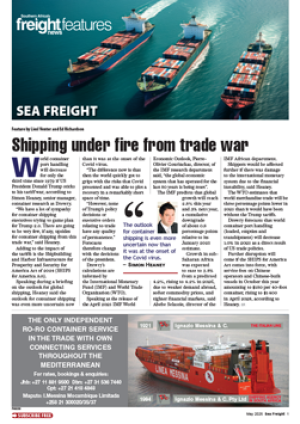The actual cost of the ship movement is probably no more than 25% of the total cost of moving a box from Johannesburg to Europe SHIPPING LINES worldwide are all on the merger and alliance bandwagon as squeezed profit margins force them to look at economies of scale to maximise their assets.
Where did it start and where is it going is the question we put to John Turner, chief executive of P&O Nedllloyd in South Africa, which is in the throes of implementing its recently-clinched merger arrangements.
To see the evolution of the consortia, alliance, merger trend, one needs to look to the northern hemisphere to start with because that's the part of the world which has the huge volumes - Europe - Far East, Far East - America, America - Europe, says Turner.
Those are really the driving forces of world trade and the world economy, trades which are 20 times the size of the trade that moves in South Africa. Competitive forces have for some time forced out many of the smaller operators.
Turner points out that while there used to be ten major British shipping lines, P&O is now the only one, and that came about as a result of alliances, consortia and mergers.
On the Far East trades shipping lines realised that they could no longer survive in small groupings, and large alliances like the Grand Alliance and the Global Alliance were formed.
This was largely motivated by the advent of 6000 teu vessels, which are difficult for a single operator to fill.
But when you look at it, we've gone as far in this industry as we can for the foreseeable future in terms of reducing the slot costs. At 6000 to 7000 teus Turner believes shipping lines have reached the optimum size of vessel. I can't see that the economies of scale would benefit very significantly from it going beyond that point.
So you've got to the stage where you've attacked that cost as much as you can and you've got to look at the other side of the business. An analysis of a container moving from Johannesburg to Europe reveals that the actual cost of the ship movement is probably no more than 25% of the total cost of moving the box, in Turner's calculation.
Spoornet for example will often charge more to move a box from Johannesburg to Durban than it would cost to move the box from Durban to the Far East or Europe. Given the fact that 25-30% is pure ship costs, the remaining 70-75% goes in the administrative requirements as well as effective buying of landside operations and maximising on the economies of scale in terms of inland movements.
Trying to do that as part of an alliance is very difficult. It's only possible as a wholly merged company, which is what happened in terms of P&O Nedlloyd.
We realised that we had already done all we could to maximise the benefits of the ships by joining alliances. The question was how to tackle the other costs, and the answer was to merge the companies. According to Turner the cost of developing the sophisticated systems needed by shippers and consignees so that they have online tracking available to them is about as much as building a container ship.
If, therefore, you are a company that has 100 ships as P&O Nedlloyd now has, you can spread the cost of developing systems over 100 ships. Smaller lines which operate maybe 15 ships only have that number over which to spread their costs. And you can see the impact of that in terms of economies of scale. While P&O Nedlloyd is unlikely to be jumping into any further merger deals in the immediate future, the industry can expect to see the merger trend gaining pace.
Joy Orlek
